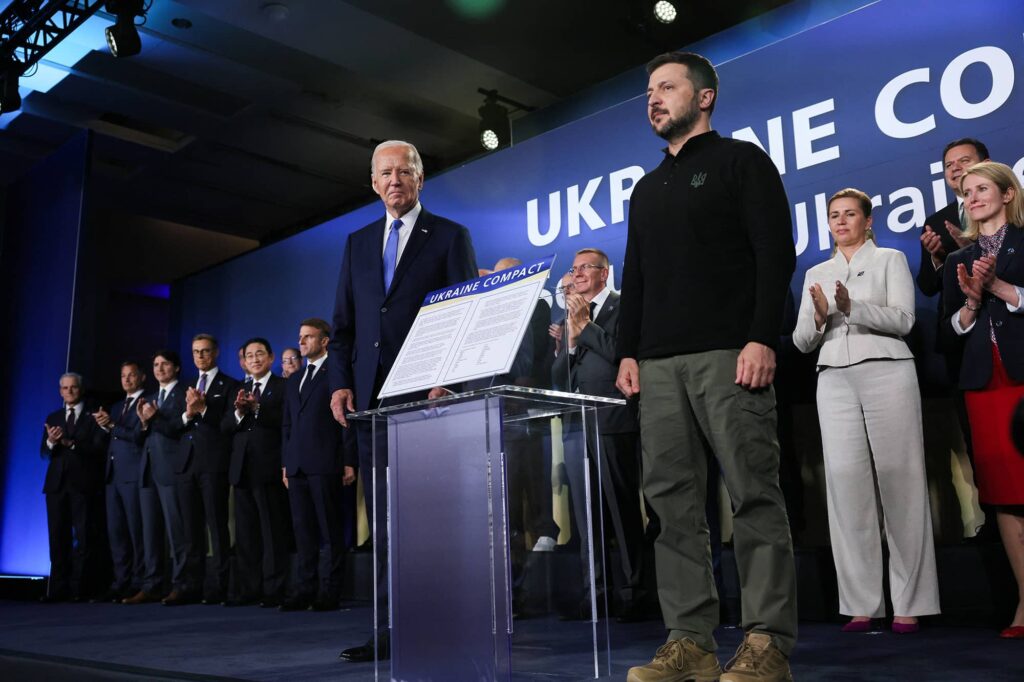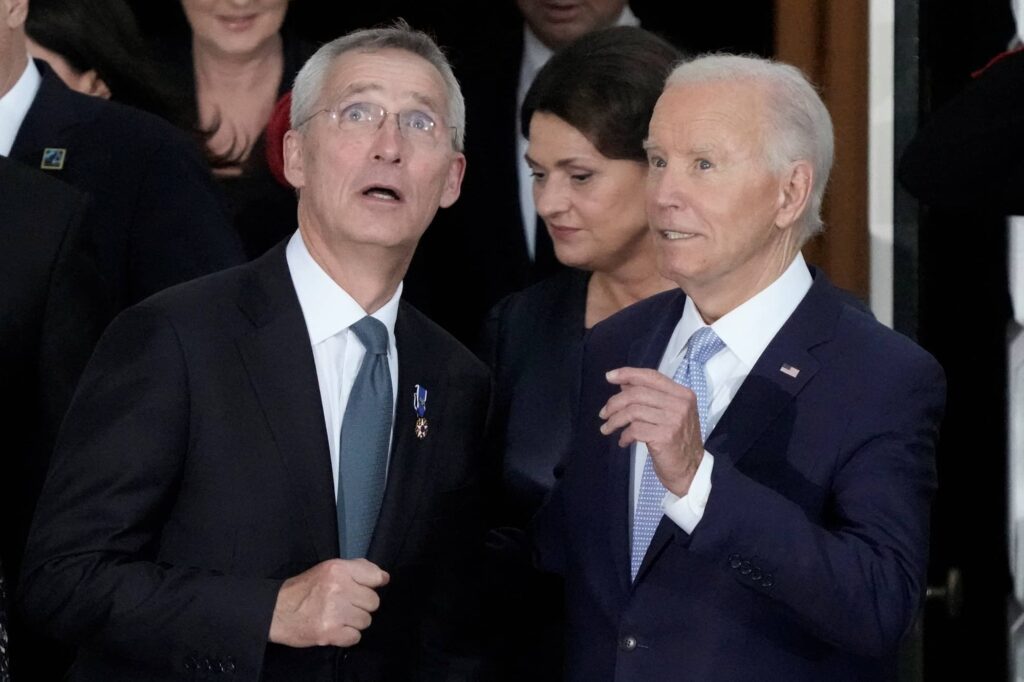The Vilnius NATO summit of 2023 was stalked by a spectre. How would the allies deal with Ukraine’s NATO aspirations while its vaunted counter-offensive had gotten off to a sputtering start, amidst nuclear saber rattling by Vladimir Putin and his henchmen, eliciting in turn a focus on “escalation management” by Joe Biden’s national security team. Vilnius ended, as all NATO summits are fated to end – as a success, despite unseemly recriminations between the Biden team and President Zelensky’s advisors.
This year’s Washington summit took place in the suffocating, sultry heat and humidity of a typical D.C. July. It gridlocked the city with intersection closures to facilitate motorcades of 32 NATO national leaders plus key Indo-Pacific allies. It was stalked by two quite different phantasms – the spectre of weak leadership among Western leaders, notably including host President Joe Biden, and what former Secretary of Defense Robert Gates has characterized as the most dangerous and challenging international security environment since World War Two.
The War in Ukraine
The questions about Ukraine which had roiled Vilnius were resolved without the contention and ill will of a year ago. The final Washington summit communique saluted the valor of the Ukrainian people for resisting Russian aggression, noted that Ukraine’s path to membership and integration with NATO was irreversible and announced additional assistance from the US and other allies to build a “bridge” for the nation’s eventual accession to the North Atlantic Treaty.
The new assistance includes air defense systems, a NATO training mission (to take place outside of Ukraine), a permanent civilian NATO Representative to Ukraine, a pledge of 40 billion Euros in long-term assistance to Ukraine by European members of NATO, and a joint NATO-Ukraine training center to apply the lessons learned from warfare in Ukraine and increase the Ukrainian Armed Forces interoperability with NATO. Biden also announced a “Ukraine Compact” which memorialized the bilateral security agreements, pledged at Vilnius, that have been reached by 22 of NATO’s 32 members plus the EU.
These steps met many of President Zelensky’s needs and much of his wish list. Left unanswered were questions about Ukraine’s ability to use long-range guided strike weapons like the ATACM missiles, which the US has finally given Kyiv, against legitimate Russian military targets inside Russia proper (as opposed to occupied Ukraine and Crimea where they are permitted under the rules set by Washington).

This spring, the Biden administration relented and allowed Ukraine to target Russian logistics, command and control, and forces marshaling for attacks against Kharkiv city. Ukrainian strikes, in fact, largely blunted the Russian assault on the country’s second largest city. Zelensky has been campaigning, so far unsuccessfully, for broader relief from the strictures against hitting Russian targets, in order to mitigate the ongoing damage from Russian SU-34 aircraft deploying glide bombs with devastating effects on Ukrainian forces and populated areas.
Other measures to remedy shortfalls in the alliance’s ability to deter conflict and defend allies were noted in the communique. Two thirds of the member states have now met the commitment to spend at least two percent of their GDP (gross domestic product) on defense; defense spending across the European allies and Canada has grown by 18 percent in one year, the “biggest increase in decades.” The communique reaffirmed the commitment for all members to meet the spending pledge and further admitted, “in many cases, expenditure beyond 2% of GDP will be needed in order to remedy existing shortfalls and meet the requirements across all domains arising from a more contested security order.”
Throwing money at the problems of deterrence and defense in Europe are insufficient. The drawdown of stocks to defend Ukraine have dramatically demonstrated the parlous state of the American and European defense industrial bases. The Vilnius Summit had adopted a Defense Production Action Plan, but deficiencies in the production base have made it difficult to reach the targets set a year ago. Hence a new NATO Industrial Capacity Expansion Pledge was adopted “to accelerate defence industrial capacity and production across the Alliance, and underscores the strategic importance of transatlantic defence cooperation.”
Especially striking about the summit was the degree to which it reflected the worsening international security environment and the globalization of politico-military challenges. The Vilnius communique had noted that China’s “ambitions and coercive policies challenge our interests, security and values.” The Washington communique went further to suggest that China “has become a decisive enabler of Russia’s war against Ukraine …and continues to pose systemic challenges to Euro-Atlantic security.” Other elements of the “axis of upheaval” contributed to the deteriorating security of Europe: “the Democratic People’s Republic of Korea and Iran are fuelling Russia’s war of aggression against Ukraine by providing direct military support to Russia, such as munitions and uncrewed aerial vehicles (UAVs), which seriously impacts Euro-Atlantic security and undermines the global non-proliferation regime.”
The summit included sessions with NATO partner countries in the Indo-Pacific region including Japan, South Korea, Australia and New Zealand. On its margins, a number of bilateral and multilateral steps were announced. The US will deploy SM-6 missiles (and prospectively hypersonic missiles) on German territory, with the latter’s agreement, providing long-range capability in Europe previously disallowed under the INF Treaty. The US, Canada, and Finland announced a new Polar initiative to expand production of ice-breakers and other capabilities to deal with competition in the Arctic. The US and South Korea announced new guidelines for nuclear deterrence and nuclear operations on the Korean peninsula in response to the DPRK’s growing nuclear arsenal and aggressive activities.
The summit communique’s language on nuclear weapons and deterrence was largely boilerplate. Left unsaid were any steps to reinforce NATO’s nuclear mission in the light of ongoing Russian nuclear threats and exercises. Nonetheless, this year’s meeting was a far cry from your grandfather’s NATO Summit.

Western Leadership
Beyond the battlefield travails of Ukraine and the tightening web of coordinated activities by the authoritarian states of Eurasia, the summit was haunted by concerns about weak Western leadership.
As the Financial Times noted, “hung parliaments, caretaker governments, and rogue mischief makers” cast a troublesome pall on the deliberations. The UK was under new management by a Labour government which won a landslide majority in Parliament, albeit with a lower vote share than it had received in a losing effort in the previous UK election. French President Macron, neutered by his own-goal snap election that has produced what may turn out to be an ungovernable situation in France, was uncharacteristically quiet during the Washington festivities. Chancellor Scholz, deeply unpopular, can scarcely provide the kind of leadership (for better or worse) that his predecessor provided.
But the overwhelming issue overshadowing all else was the future of American leadership. Former President Donald Trump’s persistent lead in the polls over the past six months had already aroused alarm in Europe about his possible return to office and what it might portend for the transatlantic alliance. His former national security advisor John Bolton has for months asserted that Trump, if returned to office, would try to withdraw the US from the alliance which it has led since 1948.
Even if President Trump were unable to withdraw from NATO (either because of existing legislation or political opposition) there is much that he could do to disrupt and damage the alliance. While the summit was underway, Trump advisors informed the media, for instance, that in a second Trump term, some of the intelligence-sharing between Washington and its allies would be limited or terminated. Moreover Trump, after the summit, met with one of the chief rogue elements in the alliance, Hungarian Prime Minister Viktor Orban, fresh off his visits to Moscow and Beijing, after which both Trump and Orban expressed the view that a victorious Trump would reach a peace agreement with Putin on Ukraine (largely by ceding those areas of Ukraine currently occupied by Russian forces).
The concerns over a potential second Trump term were only magnified by the sad spectacle of President Biden’s political meltdown in the wake of his June 27th disastrous debate performance against Trump. NATO leaders were careful to note in public that Biden appeared sharp and engaged in their various interactions during the summit. But his introduction of Zelensky as “President Putin” and reference to Kamala Harris as “Vice President Trump” while innocent enough in normal circumstances, only served to reinforce the narrative of his increasing senescence and inability to physically serve another term. The domestic American political drama of whether or not Biden would withdraw or march forward to what seems like an inexorable defeat in November is sure to haunt the alliance for the next few weeks and months.
On a more positive note, the Washington meeting marked the first time that Sweden participated as a member of the alliance. But that also highlighted the role that Hungary and Turkey had played in delaying the accession of both Finland and Sweden. More generally, the role of holdouts like Turkey or Hungary underscores the difficulties of governance of an alliance of 32 members, with rules that privilege consensus initially intended for a more compact, uniform alliance of 12, as I and several colleagues have described in detail elsewhere.
Orban was essentially quiet at the summit and did not obstruct the consensus on aid to Ukraine. But his well-known qualms, his antics before and after the summit in Beijing, Moscow and Mar a Lago make clear that he and others can make life difficult for the alliance.
The other major source of mischief in the alliance, Recep Tayyip Erdoğan, will host the 2026 NATO Summit in Turkey. After November’s election, it will remain to be seen who will be the biggest troublemaker at that summit.

